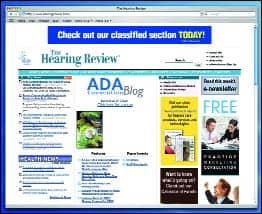Summary:
While hearing care professionals are cautiously optimistic about the potential of AI to improve patient outcomes and streamline practice operations, they stress that it must remain a supportive tool—not a replacement for human expertise and personal care in audiology.
Key Takeaways:
- AI is improving hearing aid performance and patient engagement, particularly with regard to speech in noise and auditory training apps, leading to better user outcomes.
- Audiologists see potential in AI-assisted testing and office management, but insist on clinician oversight to ensure accuracy and personalized care.
- Hearing care professionals are united in the belief that AI should enhance, not replace, their roles, emphasizing that human connection and clinical judgment are irreplaceable in effective patient care.
By Melanie Hamilton-Basich
These days, most people are of two minds when it comes to artificial intelligence (AI). “I think overall everyone’s pretty excited just about the possibility of AI improving things for our patients,” says Hunter Gerhart, AuD, director of audiology at Livingston Hearing Aid Center in Austin, TX. But like many hearing care professionals (HCPs), he is both hopeful and a bit unsure about all of the changes that AI can bring to audiology.
A large part of what gives people pause is the uncertainty about just what AI’s capabilities are and how it’s being used, partly because of terminology. It’s important to know that not everything referred to as AI is operating in the same way.
Different Kinds of AI
For instance, there’s a difference between generative AI and machine learning. Both fall under the umbrella of artificial intelligence. But machine learning is focused on identifying patterns based on data it has “learned” and making predictions based on those patterns to aid in decision making. On the other hand, generative AI such as ChatGPT is trained on enormous datasets to actually create new content, including text, images, and video.
Currently, most of the uses of AI in audiology are for machine learning. For example, audiometers can employ machine learning algorithms to automate traditional audiometric tests to improve precision and efficiency.
And many new hearing aids feature highly advanced chips that utilize machine learning to distinguish between different types of sound and make adjustments to focus on only the sounds it’s predicted the user wants to hear in different situations.
But what are hearing care professionals comfortable using AI for in their practices?
AI in Hearing Aids
The most talked about example of AI use in audiology right now is for hearing aids. And it’s not just because they’re new. It’s also because HCPs and patients are seeing the benefits of the technology.
Gerhart has been fitting more and more patients with AI-powered hearing aids at his clinic and has been impressed with their performance. “My patients have commented on just how much better they are hearing in noise,” he says. “And I believe that that increase in speech understanding in background noise is due to the way that AI is being utilized in today’s hearing aids to classify the different sound sources.”
Julie Prutsman, AuD, CH-TM, owner and founder of Sound Relief Tinnitus & Hearing Center based in Colorado, also welcomes the use of AI technology in hearing aids. “AI is definitely helping to better isolate speech in noise, I think for sure,” she says.
But Prutsman also sees the benefit of AI in hearing aids helping patients adjust settings in noisy situations. Without such assistance, she knows many people get overwhelmed struggling to determine which settings to adjust and how much, so they give up.
“For a technology to help them through that, to keep them in that environment and keep them confident, keep them engaged, is really the ultimate goal so they don’t self-isolate,” she says. “Because we know social isolation is what can lead to depression, which can lead to cognitive decline, which can lead to all sorts of negative side effects.
“So it’s definitely neat to see AI being incorporated into app controls and into hearing aid chips, and I think it’s going to continue to improve.”
AI in Hearing Aids in the News:
GN ReSound Unveils AI-Powered Hearing Aid with Bluetooth LE Audio Support
New Oticon Jet PX MiniRITE Hearing Aid Features DNN Technology
Phonak Launches Infinio Hearing Aid with Real-Time AI
Signia Debuts Pure Charge&Go BCT IX Hearing Aids
Starkey Unveils Hearing Aids with Advanced Processing, Connectivity
Unitron Unveils AI-Powered Smile Hearing Platform with Universal Connectivity
Widex Unveils Widex Allure Hearing Aids and Cloud-Based Fitting Software
Auditory Training
AI can also be used for aural rehabilitation. Prutsman has found success with an auditory training app called Lace AI Pro that uses AI to help patients learn how to better understand speech in noise.
Interactive lessons increase in difficulty to continue challenging the patient if they’re doing well. But if the AI determines the patient is struggling too much to understand the words, it will make the lessons a bit easier so the patient doesn’t get frustrated and give up. Prutsman appreciates how the app uses AI to constantly adjust difficulty in response to the user’s skill level because it helps keep them stay engaged over the long term, which is important for continued improvement.
“Patients aren’t really realizing that the exercises are getting a little bit harder or easier,” Prutsman says. “I think that’s a good thing that patients aren’t really noticing the algorithms working behind the scenes, but they’re definitely benefiting from them.”
Hearing Testing
When it comes to using AI to streamline hearing testing, audiologists’ reactions are more measured. They’re open to assistance up to a point.
“I think AI could be beneficial to help with screening out normal hearing or standard age-related hearing loss,” says Jessica Stiel, AuD, CCC-A, who works at The Ohio State University Wexner Medical Center. “And then as the clinician, I would be able to identify the red flags where a referral might be needed, if there was an asymmetric loss or a conductive loss, so it could help diagnose in that regard. Then I would have more clinical time and judgment to spend on the more complex cases.”
Stiel sees this as similar to how hearing aid software incorporating AI is currently used. “You start with an initial fit based on the user’s experience and their age and their hearing loss. And then that’s kind of preset,” she says. “And then based on how they do and what their complaints are, that’s where we come in as the professionals knowing how to make adjustments to accommodate whatever issues or complications they’re having.”
Prutsman also sees the benefits of AI taking over some of the basic hearing testing—but only with direct oversight from HCPs.
“You have to make sure what’s going into the algorithm is good data, to get out the results you’re looking for. So we would have to cross-check it,” emphasizes Prutsman. “Otherwise something could get missed or inaccurately diagnosed. You would definitely need to have some clear parameters to make sure that didn’t happen. But if we could get there, which I think they are definitely working on, it could help.”
And with a projected significant shortage of audiologists in the very near future, Prutsman sees this solution becoming especially useful. “If we could use AI to help fill some of the gaps in the number of providers needed to meet the demand, that could really be great for workflow and for better patient care, really,” she says.
For his part, Gerhart is concerned about the extent of AI’s reach in audiology testing. “I would not want to see AI replacing the diagnostician and the treatment of hearing loss, because hearing loss is not something that can be self-identified,” he says. “It’s really hard to get a proper diagnosis, and degree and severity of the loss, without having a test that’s performed by a licensed hearing healthcare professional.”
Office Management
The use of AI is not confined to HCPs themselves, of course. Many tasks that staff members must complete to make sure a practice runs smoothly can also involve AI these days.
Office management software is increasingly offering AI features to streamline processes and enhance practice efficiency. These include voice-to-text dictation, the ability to create auto-replies via text and email, and language translation.
At the practice where Stiel works, staff use AI features in their office management software for scheduling appointments, which she says has been extremely useful.
While the software Prutsman’s clinic uses doesn’t currently use AI, she’s open to using a system that does. “If AI could help with that puzzle of ideal patient scheduling in a day, that would make my life a lot easier because we spend a lot of time trying to figure out the perfect schedule,” she says.
Marketing
AI can also be used for marketing. Prutsman’s husband is in charge of all of the marketing for her practice, and he says using generative AI in the form of ChatGPT to create promotional materials has been a game changer.
“He spends way less time on having to edit and create the perfect content because with the help of AI he can really customize the message to fit the format or the language that he’s looking for for a particular marketing piece,” Prutsman says. “He’ll take a concept and say, ‘Here’s what we want to say. Can you make it more informational, or more relatable?’ Or, ‘Can you find a funny tagline for this blog post?’ So it’s just pretty amazing what you can do and how the more you use it, the more it learns what your preferences are and then it starts becoming easier and easier to get the end product that you’re really looking for.”
But Prutsman also notes that you always need to check to make sure the content ChatGPT generates is actually what you want and doesn’t contain errors or fabricated information. It still requires human oversight.
A Tool, Not a Replacement
While HCPs tend to agree that AI can be useful, they also agree that they don’t want it to replace them.
“Overall, I think it’s a powerful tool, but it’s not a substitute for clinical expertise,” says Stiel. “I feel like most of us are open to AI or excited about it, so long as we get to remain a part of the process.”
Concern about overreliance on AI to the detriment of hearing care professionals and patients is not unfounded.
In Facebook groups for people with hearing loss, Gerhart regularly sees posts from people asking HCPs to interpret their test results. “While there are a lot of great qualified professionals in these forums who will often chime in and help these users understand their results, as AI technology improves and becomes more readily available, I fear that consumers may turn to those sources before they turn to a professional,” he says. “I wouldn’t want them to replace the expertise of a hearing healthcare professional with AI.”
It seems that some companies are already working on making what Gerhart fears a reality.
Stiel was recently contacted by a company looking for audiologists to answer questions related to hearing care for a fee. “I think they’re trying to teach their AI database how to answer these questions to create a kind of medical ChatGPT,” she says. And it wouldn’t surprise her if it came to fruition, although she hopes it doesn’t.
“I think that it’s key to use AI as a tool, not a replacement,” Stiel emphasizes. “Hearing care is deeply personal, and no algorithm can replace clinical judgment or human understanding of context.”
Gerhart also strongly believes that personal interaction in healthcare will always trump artificial intelligence. “I think that there is a fundamental component of quality hearing healthcare, and I think that’s the human touch, being able to have a one-on-one interaction with a hearing care professional where we can guide patients through how to overcome the challenges that they’re experiencing, which I don’t think AI can deliver.”
Featured image: ID 143574018 | Ai © Blackboard373 | Dreamstime.com





